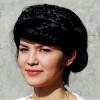It's only a couple of days ago that I was able to visit the marvellous Fra Angelico exhibition currently on show at the San Marco Museum and the Strozzi Palace in Florence. The exhibition is in its final days and will end on 25 January 2026, so if you are in Florence now or have the possibility to be here before then, don't hesitate - this is an amazing display of the works of Fra Angelico of Fiesole (ca. 1395 - 1455) and other artists associated with him and his times. Fra Angelico was born around 1395, named Guido di Pietro, in the Tuscan area of Mugello near Fiesole, not far from Florence. He was one of the greatest painters of the late Gothic and early Renaissance during the 15C, his only competitor, and perhaps superior, in painting during the first part of his life being Masaccio who died at age 26, and Fra Filippo Lippi later. For this exhibition the organisers have gathered over 140 works from Florence and around the world. The exhibition catalogue follows the layout of the exhibition closely and contains illustrations of many of the works on display. Despite its expense (€80), the catalogue is indispensable. (I suspect it will show up on Amazon at a substantial discount after the exhibition closes.) I recommend that you book a time slot first for San Marco since the museum is open only in the morning, and then go on to Palazzo Strozzi after lunch, if you plan to see the entire exhibition in one day.

In this review, I'll emphasize some aspects of Fra Angelico's artistic output and other items on display that especially interested me and which might be less familiar to my faithful readers.
San Marco Museum
All of Fra Angelico's admirers as well as huge numbers of other art enthusiasts will already be familiar with the frescoes he painted in the monks' cells in the Monastery of San Marco by commission of his first and greatest patron, Cosimo de Medici, the Elder. These frescoes form the major part of the exhibition at San Marco.
Fra Angelico: fresco in cell 7, The Mocking of Christ In addition, there is a small but absorbing exhibition of items associated with the fanatical monk, Savonarola (1452 - 1498) who occupied Fra Angelico's former cell some thirty years after Fra Angelico had left the monastery. The famous portrait of Savonarola by Fra Bartolomeo can be viewed close up alongside an extremely expressive terracotta bust of Savonarola attributed to Marco della Robbia, later Fra Mattia (1468-1534). The display also includes a manuscript written by Savonarola in exquisite and minute script - BE SURE TO BRING A LARGE MAGNIFYING GLASS WITH YOU (see the next paragraph).
Terracotta bust of Savonarola attributed to Marco della Robbia
The San Marco Monastery Library
 The San Marco Library during the Fra Angelico Exhibition.
The San Marco Library during the Fra Angelico Exhibition.
Not everyone realises that Fra Angelico was a skilled miniaturist and illustrator of illuminated manuscripts and this aspect of his artistic output should definitely not be thought of as being somehow a secondary activity, as indeed the exquisite examples of his illuminations on display in the library of San Marco Monastery demonstrate. Looking into the library from the main door, on the left are manuscripts and other sheets containing work by Fra Angelico while on the right are manuscripts that originally belonged to the library but which have been dispersed around the world following the depredations of Napoleon. Many of the manuscripts are humanistic works, some of them collected by the Medici family and donated to the library. The miniatures deserve to be examined under a magnifying glass in many cases. One example, which I can't find in the exhibition catalogue, is the only significant surviving page, the frontispiece, from Silius Italicus: De bello punico, 1450, a manuscript poem in the Biblioteca Nazionale Marciana, illuminated by most likely by Zanobi Strozzi, who was strongly influenced by Fra Angelico. (Click the image to study the details, especially the birds.)

Another example, Saint Thomas Aquinas lecturing, from an Antiphonary for the Proper of Time, by Fra Angelico and collaborators, dating from about 1440-42.
The Strozzi Palace
The major part of the exhibition is located at the Palazzo Strozzi where almost all of the surviving major works by Fra Angelico are displayed. This part of the exhibition provides excellent insight into Fra Angelico’s artistic development and influence, and his relationship to painters such as Lorenzo Monaco, Masaccio, and Filippo Lippi, as well as sculptors like Lorenzo Ghiberti, Michelozzo, and Luca della Robbia.
Fra Angelico: the Coronation of the Virgin painted for the Church of Santa Maria Novella
When we first see the Coronation of the Virgin painted for the Church of Santa Maria Novella in Florence and the other works displayed around it, all the elements that a very expensive altarpiece of the 14 C was expected to provide leap out - a precisely tooled gold background, much azure, and much vermilion, the gilded haloes and gold-edged robes. What we are seeing at first seems all very Gothic but what makes this a Renaissance painting is the three dimensional depth and
naturalism of the figures and the realism of their garments. The exhibition allows the viewer to follow Fra Angelico from Late Gothic to Early Renaissance - compare the images directly above and directly below.
Fra Angelico: Naming of St John the Baptist
I want to mention three other works from the period of Fra Angelico displayed here. The first is one of Luca della Robbia's masterpieces, the Virgin of the Apple ca. 1440-1445. Aside from the great beauty of this piece, where the only colour used is for the eyes of the Madonna and of the Child, a curiosity of the work is that the terracotta figures are placed against an apparently brocade design but which in fact includes two hidden paintings of the Madonna and Child, one painted overlaying the other. The more recent and visible painting is by Michele di Ridolfo del Ghirlandaio or his workshop, while the underlying work, viewed using infrared reflectography, is attributed to Domenico di Michelino (1417-1491).
Luca della Robbia the Virgin of the Apple
My faithful and intelligent readers will undoubtedly recall my obsession with the
Medici family. I was delighted to be able to view up close an extremely evocative marble relief (but look at it from the left side - it's almost a sculpture in the round) of
Cosimo de' Medici, the elder, by
Antonio Rossellino dating from ca. 1460-64. Cosimo was the first patron of Fra Angelico.
Antonio Rossellino: Cosimo de' Medici
Cosimo's son and the father of Lorenzo il Magnifico, was Piero (1416-1469), known as "the gouty" due to his sufferings from this disorder later in his short life. Not only is the bust of Piero on display a fine sculpture, it is one of the first objects of this kind where the provenance is clear. The various inscriptions under its base identify the artist as Mino da Fiesole, state that the subject is Piero de' Medici and that Piero was 37 years old at the time (1453-54).
Mino da Fiesole: Piero di Cosimo de' Medici
As I staggered through this splendid exhibition (believe me, after three hours the legs grow weary), I was reminded again and again how Fra Angelico's originality, based on the foundations laid almost a century previously by Cimabue and then his pupil Giotto, finds expression in Fra Angelico's pupil Benozzo Gozzoli's portraiture and
technical expertise in the art of fresco. Gozzoli links to Domenico Ghirlandaio and so to the latter's pupil Michelangelo and hence to the High Renaissance.
 |
Don't forget to visit my Tuscany
Travel Guide!
Up-to-date news on what to see and where to stay in Chianti and all of Tuscany.
Tuscany Travel Guide
|
|
Author: Anna Maria Baldini






































